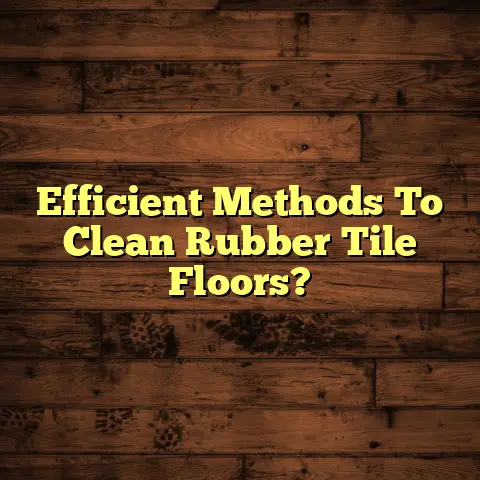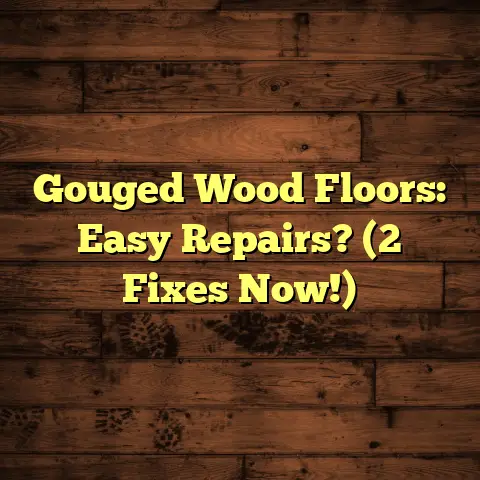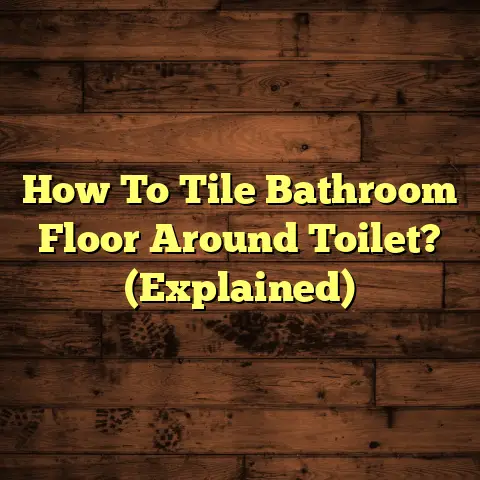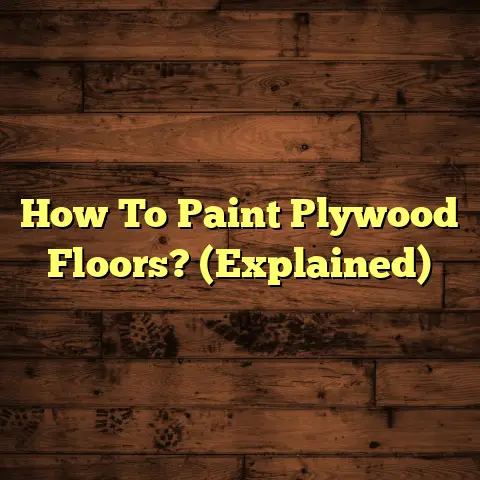Cleaning 100-Year-Old Floors? (5 Pro Secrets!)
As a flooring contractor with years of experience wrestling with all sorts of floors, I’ve seen firsthand the magic that can happen when you breathe new life into old wood.
And let me tell you, nothing beats the character and charm of a century-old floor. But keeping them clean? That’s a whole different ballgame.
It’s not just about aesthetics; it’s about preserving a piece of history and boosting your home’s value.
Trust me, those original hardwood floors can be a major selling point! Let’s dive in.
Introduction
Let’s talk about something near and dear to my heart: 100-year-old floors.
These aren’t just surfaces we walk on; they’re time capsules, whispering stories of generations past.
And believe it or not, they can seriously impact your home’s resale value.
Think about it: When potential buyers walk into a home and see beautifully maintained original hardwood floors, what’s the first thing that comes to their mind?
It’s quality, craftsmanship, and a sense of history. It’s an instant upgrade in their eyes.
I’ve seen it happen time and again. Homes with well-preserved original floors fetch higher prices and attract more interest.
According to the National Association of Realtors, homes with hardwood flooring often sell for as much as 2.5% more than homes without.
That might not sound like a lot, but on a $500,000 home, that’s $12,500!
But here’s the catch: those floors need to be in good shape. We are talking about 100-year-old floor!
Neglected, dirty, or damaged floors can actually detract from your home’s appeal. Nobody wants to see grime and scratches.
That’s why cleaning and maintaining these vintage gems is so crucial.
It’s about finding that sweet spot between preserving their historical charm and ensuring they look clean and inviting.
Think of it as giving your home a facelift that highlights its best features.
In this article, I’m going to share my top five pro secrets for cleaning 100-year-old floors.
These are the tips and tricks I’ve learned over years of experience, working with all kinds of antique flooring.
Whether you’re prepping your home for sale or simply want to enjoy the beauty of your original floors, these secrets will help you keep them looking their best.
So, let’s get started and unlock the potential of your vintage floors!
Section 1: Understanding Your 100-Year-Old Floors
Before you even think about grabbing a mop, it’s essential to understand what you’re working with.
Not all old floors are created equal, and the wrong cleaning approach can do more harm than good.
1.1 Identify the Flooring Material
First things first: What kind of wood are we talking about?
In homes built a century ago, you’ll typically find a few common types of flooring:
-
Oak: This is probably the most common. Oak is durable, readily available, and has a beautiful grain pattern. You’ll often see it in older homes.
-
Pine: Pine is softer than oak and has a more rustic look. It was often used in less formal areas of the house.
-
Maple: Maple is known for its light color and smooth grain. It’s a very durable wood, perfect for high-traffic areas.
-
Linoleum: In some kitchens and bathrooms, you might find early forms of linoleum. These are different from modern vinyl and require special care.
So, how do you tell the difference?
Oak typically has a very pronounced grain pattern, with visible rings and patterns.
Pine tends to be softer and can have knots and a more rustic appearance.
Maple is usually lighter in color and has a very tight, almost invisible grain.
Linoleum is not wood at all, but a composite material that can come in various colors and patterns.
If you’re unsure, take a close-up photo and compare it to images online, or better yet, consult with a flooring professional.
Once you know what you’re dealing with, you can tailor your cleaning approach accordingly.
Each material has its own unique characteristics and reacts differently to various cleaning solutions.
For instance, pine is more porous than oak and can absorb liquids more easily, so you’ll want to be extra careful with water.
1.2 Assessing the Condition of the Floors
Okay, you’ve identified the type of flooring. Now, let’s take a closer look at its condition.
Before you start cleaning, inspect the floors for any signs of damage or issues.
Here’s what to look for:
-
Wear Patterns: Are there areas with excessive wear, such as near doorways or in high-traffic zones?
-
Scratches and Dents: These are common in old floors, but deep scratches can trap dirt and grime.
-
Water Damage: Look for stains, discoloration, or warping, which could indicate water damage.
-
Loose Boards: Check for any boards that are loose, squeaky, or shifting.
-
Previous Repairs: Notice any patches or repairs that might have
been done in the past.
Documenting the condition of your floors is crucial, not just for your own records, but also for potential resale conversations.
Take photos of any damage or issues, and make notes about their location and severity.
This will give you a clear picture of what you’re dealing with and help you prioritize your cleaning and maintenance efforts.
Plus, if you ever decide to sell your home, you can show potential buyers that you’ve been proactive in maintaining the original flooring.
1.3 Historical Value and Restoration
Let’s not forget the historical significance of maintaining original flooring.
These floors aren’t just pretty; they’re a tangible link to the past. They’ve witnessed countless moments and are part of your home’s unique story.
Preserving them is about more than just aesthetics; it’s about honoring the craftsmanship and history of your home.
And, as I mentioned earlier, it can also increase your home’s value.
Restoring original flooring can be a significant investment, but it often pays off in the long run.
According to a study by This Old House, restoring original features, like hardwood floors, can increase a home’s value by as much as 10%.
That’s a pretty compelling reason to take care of those old floors!
Now, I’m not saying you need to embark on a full-scale restoration project.
Sometimes, a good cleaning and some basic maintenance are all it takes to bring out the beauty of your original flooring.
But if you’re considering selling your home, it’s definitely worth exploring the possibility of professional restoration.
It could be the one thing that sets your home apart from the competition and helps you get top dollar.
Section 2: The Pro Secrets to Cleaning 100-Year-Old Floors
Alright, now for the good stuff.
Here are my top five pro secrets for cleaning 100-year-old floors, based on years of experience working with all kinds of antique flooring.
2.1 Secret #1: Gentle Cleaning Solutions
This is probably the most important secret of all: When it comes to old floors, less is definitely more.
Harsh chemicals and abrasive cleaners can strip away the finish, damage the wood, and leave your floors looking worse than before.
Instead, opt for gentle, pH-neutral cleaning solutions. These are designed to clean without damaging the surface.
You can find pH-neutral cleaners at most hardware stores or online. Just make sure to read the label carefully and choose a product that’s specifically designed for hardwood floors.
Or, if you’re feeling crafty, you can make your own DIY cleaning solution.
Here’s one of my favorite recipes:
- 1/4 cup white vinegar
- 1 gallon of warm water
- A few drops of mild dish soap
(optional)
Mix the ingredients together in a bucket and you’re good to go.
Vinegar is a natural cleaner that helps to remove dirt and grime without damaging the finish.
The dish soap is optional, but it can help to cut through grease and stubborn stains. Just make sure to use a very small amount, as too much soap can leave a residue.
Another great option is using baking-soda. It is a natural cleaner that helps to remove dirt and grime without damaging the finish.
It is very effective in removing stains and grease from the floor.
No matter what cleaning solution you choose, always test it in an inconspicuous area first to make sure it doesn’t damage the finish.
Apply a small amount of the solution to a hidden corner of the floor and let it sit for a few minutes.
If there’s no discoloration or damage, you’re good to go.
2.2 Secret #2: The Right Tools Matter
Using the right tools can make a huge difference in the effectiveness of your cleaning efforts.
Here are some essential tools for cleaning old floors:
-
Microfiber Mop: These mops are gentle on floors and do a great job of picking up dirt and dust.
-
Soft-Bristled Brush: Use this for scrubbing stubborn stains or dirt in hard-to-reach areas.
-
Vacuum Cleaner: A vacuum with a soft brush attachment is perfect for removing loose dirt and debris before you start mopping.
-
Microfiber Cloths: These are great for wiping up spills and drying the floor after mopping.
Avoid using abrasive scrub brushes or steel wool, as these can scratch and damage the finish.
Microfiber cloths are your best friend when it comes to cleaning old floors.
They’re incredibly soft and absorbent, and they won’t scratch the surface.
Plus, they’re machine washable, so you can use them over and over again.
When you’re mopping, make sure to use a microfiber mop with a removable head. This will allow you to easily wash the mop head after each use, preventing the spread of dirt and bacteria.
And when you’re vacuuming, always use a vacuum cleaner with a soft brush attachment.
This will prevent the vacuum from scratching the floor.
2.3 Secret #3: The Cleaning Technique
Now that you have the right tools and cleaning solution, let’s talk about the cleaning technique.
The key here is to be gentle and patient. Don’t rush the process, and don’t apply too much pressure.
Here’s a step-by-step guide to cleaning 100-year-old floors:
-
Vacuum: Start by vacuuming the floor to remove any loose dirt and debris.
-
Prepare Your Cleaning Solution: Mix your chosen cleaning solution according to the instructions.
-
Dampen Your Mop: Dip your microfiber mop into the cleaning solution and wring it out thoroughly. You want the mop to be damp, not soaking wet.
-
Mop the Floor: Working in small sections, gently mop the floor, following the grain of the wood.
-
Dry the Floor: Use a clean, dry microfiber cloth to dry the floor immediately after mopping. This will prevent water from soaking into the wood.
-
Repeat: Repeat the process until the entire floor is clean.
When you’re mopping, always work with the grain of the wood. This will help to prevent streaks and ensure that you’re cleaning the floor evenly.
And be sure to avoid excessive water exposure. Old floors are more susceptible to water damage than new floors, so it’s important to keep them as dry as possible.
If you spill something on the floor, wipe it up immediately with a clean, dry cloth.
2.4 Secret #4: Regular Maintenance Routines
Consistency is key when it comes to keeping old floors in pristine condition.
A regular cleaning and maintenance schedule will help to prevent dirt and grime from building up and keep your floors looking their best.
Here’s a sample maintenance schedule:
-
Daily: Sweep or vacuum the floor to remove loose dirt and debris.
-
Weekly: Mop the floor with a gentle cleaning solution.
-
Monthly: Inspect the floor for any signs of damage or wear, and address them promptly.
In addition to regular cleaning, there are also some preventative measures you can take to protect your floors from damage.
-
Use Area Rugs: Place area rugs in high-traffic areas to protect the floor from wear and tear.
-
Use Furniture Pads: Put furniture pads under the legs of your furniture to prevent scratches and dents.
-
Trim Your Pets’ Nails: Keep your pets’ nails trimmed to prevent them from scratching the floor.
-
Avoid Wearing Shoes Indoors: Encourage family members and guests to remove their shoes before entering the house.
2.5 Secret #5: Professional Help When Necessary
Sometimes, no matter how hard you try, you just can’t get your old floors looking their best.
That’s when it’s time to call in the pros.
Professional cleaning and restoration services can work wonders on old floors.
They have the expertise, equipment, and products to remove stubborn stains, repair damage, and restore the finish.
Here are some signs that it’s time to seek professional help:
-
Deep Scratches: If your floors have deep scratches that you can’t remove with regular cleaning, a professional can sand them down and refinish the floor.
-
Water Damage: If your floors have water damage, a professional can repair the damaged boards and restore the finish.
-
Fading Finish: If the finish on your floors is faded or worn, a professional can apply a new coat of finish to restore their shine.
Hiring a professional to restore your floors can be a significant investment, but it can also be a great way to increase your home’s value.
According to Remodeling Magazine’s Cost vs. Value Report, hardwood floor refinishing has a national average ROI of around 70%.
That means that for every dollar you spend on refinishing your floors, you can expect to get back 70 cents in increased home value.
Plus, a professionally restored floor will look amazing and make your home more enjoyable to live in.
Section 3: Enhancing Resale Value Through Floor Maintenance
We’ve talked a lot about cleaning and maintaining old floors, but let’s get down to brass tacks: How does this all translate into increased resale value?
As I mentioned earlier, homes with well-maintained original hardwood floors tend to fetch higher prices and attract more interest from buyers.
But it’s not just about having hardwood floors; it’s about having hardwood floors that look their best.
Investing time and effort into cleaning and restoring your old floors can pay off big time when it comes time to sell your home.
Here are some examples of homes that appreciated in value after floor restoration:
-
A home in San Francisco saw a $50,000 increase in value after the original hardwood floors were restored.
-
A home in Chicago sold for $25,000 over asking price after the hardwood floors were refinished.
-
A home in Boston received multiple offers after the hardwood floors were professionally cleaned and polished.
These are just a few examples, but they illustrate the point: Buyers are willing to pay a premium for homes with beautifully maintained original features.
So, how can you present your floors during showings to attract buyers?
Here are some tips:
-
Clean and Polish: Make sure your floors are spotless and shining before every showing.
-
Stage the Room: Arrange furniture to highlight the beauty of the floors.
-
Use Area Rugs Strategically: Place area rugs in high-traffic areas to protect the floors, but don’t cover them up completely.
-
Highlight Original Features: If your floors have any unique features, such as intricate patterns or rare wood, be sure to point them out to potential buyers.
-
Provide Documentation: Have documentation available showing the age and history of the floors, as well as any restoration work that has been done.
By taking these steps, you can showcase the beauty of your original flooring and make a lasting impression on potential buyers.
Conclusion
So, there you have it: My five pro secrets for cleaning 100-year-old floors.
Let’s recap:
-
Gentle Cleaning Solutions: Use pH-neutral cleaners or DIY solutions to avoid damaging the finish.
-
The Right Tools Matter: Invest in microfiber mops, soft-bristled brushes, and vacuum cleaners with soft brush attachments.
-
The Cleaning Technique: Be gentle and patient, working with the grain of the wood and avoiding excessive water exposure.
-
Regular Maintenance Routines: Establish a regular cleaning and maintenance schedule to prevent dirt and grime from building up.
-
Professional Help When Necessary: Don’t hesitate to call in the pros if you can’t get your floors looking their best.
Maintaining your old floors is not just about preserving history; it’s about enhancing the current and future value of your home.
By following these secrets, you can keep your floors looking their best for years to come and potentially increase your home’s resale value.
So, take pride in your vintage flooring and view the cleaning process as an investment in your property’s longevity and market appeal.
Trust me, it’s worth it!





